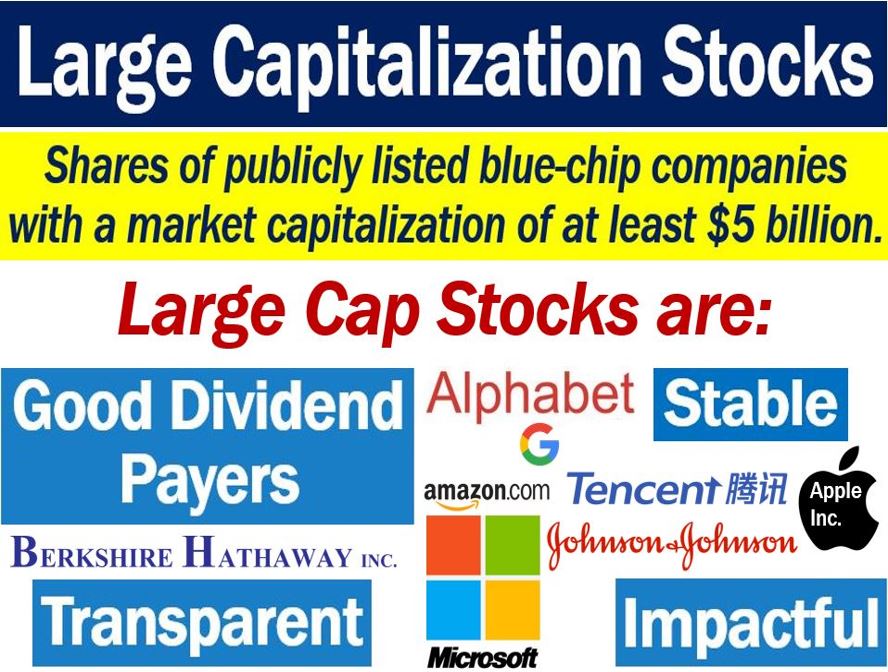Large capitalization stocks are the shares of blue-chip public companies with a market capitalization of at least $5 billion. The term is more common in the United States than in the United Kingdom. The Dow Jones Industrial Average and the Standard and Poor’s 500 (S&P 500) track the value of these companies’ shares. Large capitalization stocks belong to companies which are major drivers of the national economy.
The Dow Jones Industrial Average (Dow) is an index that represents the weighted average of the thirty major NYSE stocks. NYSE stands for New York Stock Exchange. The S&P 500 is a stock market index that includes the 500 largest companies listed on the NYSE or NASDAQ.
Rather than saying large capitalization stocks, many people use the short form, i.e., large cap stocks. It is also common simply to say ‘large cap’ or ‘big cap’ companies or stocks.

What is capitalization?
In this context, capitalization is the total number of a company’s shares outstanding times the price of each share. We also use the term ‘market capitalization‘ with the same meaning.
Shares outstanding refers to all the shares that a company has authorized and issued.
Let’s suppose that fictitious company John Doe Inc. has 100,000 shares outstanding and that each share is worth $10,000. John Doe’s market capitalization, therefore, is $1,000,000,000, i.e., one billion dollars.
Large capitalization stock
Below is the large capitalization stocks ‘top ten’ for the last quarter of 2017. The list contains the name of each company as well as its market capitalization.
1. Apple Inc. $868,880 million.
2. Alphabet Inc. $727,040 million.
3. Microsoft $659,910 million.
4. Amazon.com $563,540 million.
5. Facebook $512,760 million.
6. Tencent $493,340 million.
7. Berkshire Hathaway $489,490 million.
8. Alibaba Group $440,712 million.
9. Johnson & Johnson $375,360 million.
10. JPMorgan Chase $371,050 million.
Large capitalization stocks and portfolios
Large capitalization stocks represent approximately 91% of America’s equity market.
In fact, large capitalization stocks make up much of the average investor’s portfolio.
Large cap stock companies have the following features in common:
– Dividends: they have a good track record regarding dividend income distribution. Because they are stable companies and established market leaders, they can more easily commit to high dividend payout ratios. Dividend payouts of small cap companies, on the other hand, tend to be unpredictable.
– Stable: large cap companies’ shares do not fluctuate as steeply as those of small cap companies. In a bear market, for example, small capitalization stocks tend to decline further than large capitalization stocks.
– Transparency: is a way of life for large cap companies. Investors like their transparency because they can easily access information about them.
– Impactful: large cap stock companies are huge. What happens to them has an important impact on the market.
Major Market Index
Officially the NYSE Arca Major Market Index, this index comprises 20 blue-chip company stocks. Seventeen of them are on both the NYSE and Dow Jones Industrial Average.
Futures and options traders base their purchases and sales on this index.
